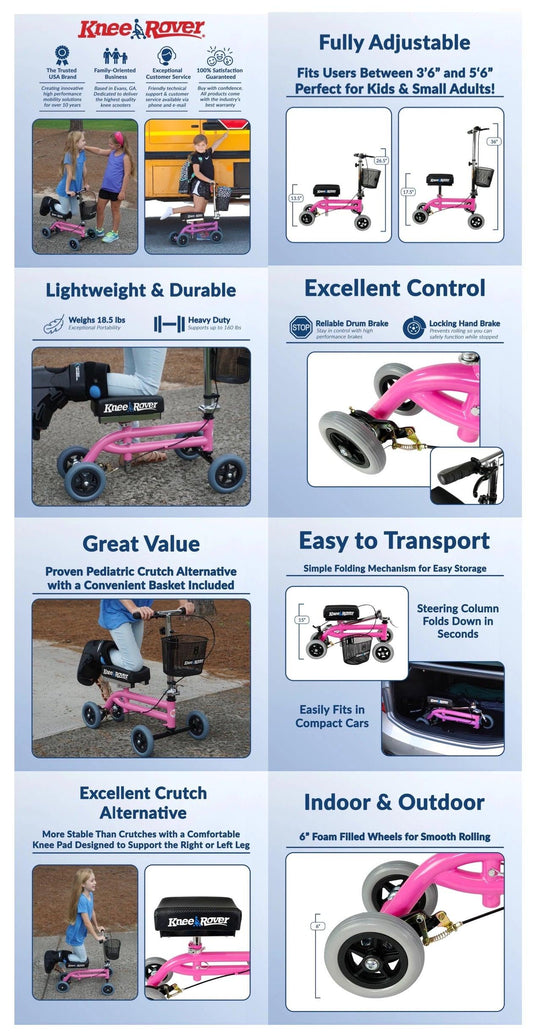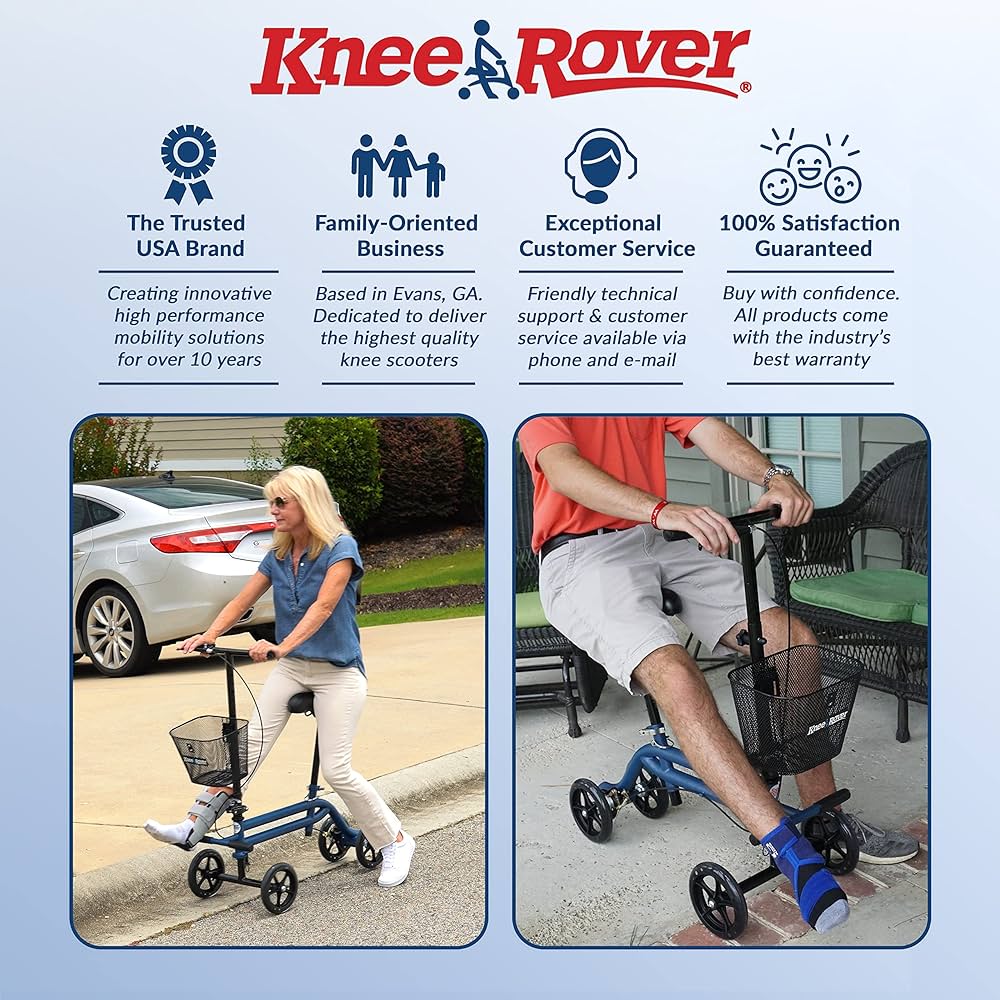A knee scooter is significantly easier and more natural-feeling when doing chores, going to the store, working, and even going on vacation compared to a knee crutch. You are able to move about freely without the troubles of crutches or a wheelchair, and you will not depend on others to help.
Having an injured leg can severely limit your mobility and independence. However, with the advent of mobility devices like knee crutches and knee scooters, individuals with lower leg injuries or disabilities have options to assist them in their everyday activities.
While both knee crutches and knee scooters serve the same purpose of providing support and assistance, they have distinct differences in terms of functionality and ease of use. Understanding the advantages and disadvantages of each device can help you make an informed decision on which one would be better suited for your specific needs. We will compare knee crutches and knee scooters, highlighting the benefits and drawbacks of each to help you in your decision-making process.

Credit: kneerover.com
Understanding Knee Crutches And Knee Scooters
When it comes to comparing knee crutches and knee scooters, a knee scooter is easier to use and provides more freedom of movement for daily tasks and even traveling. With a knee scooter, you can navigate without relying on others and experience a more natural-feeling mobility option.
Definition Of Knee Crutch
A knee crutch, also known as a hands-free crutch or hands-free knee scooter, is a mobility aid used by individuals with lower leg injuries or disabilities. It is designed to provide support and assistance while allowing the user to remain hands-free. Unlike traditional crutches, a knee crutch is strapped around the thigh, providing stability and support to the injured leg. It typically features a padded platform or cushioned pad to rest the injured leg, and adjustable straps to secure it in place. With the use of a knee crutch, individuals can navigate and move around without placing weight on the injured leg.
Definition Of Knee Scooter
On the other hand, a knee scooter, also referred to as a knee walker, is another type of mobility device used by individuals with lower leg injuries or disabilities. It is designed to provide support and aid in mobility while alleviating the need for crutches or wheelchairs. A knee scooter features a padded platform or cushioned pad to rest the injured leg, and a handlebar for steering and control. The user propels themselves forward by pushing off the ground with their non-injured leg. This allows individuals to move around more freely and independently, without dependence on others or assistance.
Comparison Between Knee Crutch And Knee Scooter
Both knee crutches and knee scooters serve the purpose of providing assistance and support to individuals with lower leg injuries or disabilities. However, they differ in terms of design and functionality.
| Feature | Knee Crutch | Knee Scooter |
|---|---|---|
| Design | Around-the-thigh strap | Padded platform with handlebar |
| Mobility | Hands-free | Requires manual propulsion |
| Weight-bearing | Allows weight on the injured leg | Non-weight bearing on the injured leg |
| Maneuverability | Limited agility | Easy maneuverability |
In summary, knee crutches and knee scooters are both valuable mobility aids for individuals with lower leg injuries or disabilities. The choice between the two ultimately depends on individual preferences and needs. Knee crutches offer hands-free mobility and the ability to bear weight on the injured leg, while knee scooters provide easy maneuverability and non-weight bearing on the injured leg. Consider consulting with a healthcare professional to determine the most suitable option for your specific situation.

Credit: kneerover.com
Pros And Cons Of Knee Scooters
A knee scooter, also known as a knee walker, offers several advantages over traditional crutches or wheelchairs. These advantages make it a popular choice for individuals with lower leg injuries or disabilities.
Increased Mobility And Independence
A knee scooter allows you to move about freely without the limitations of crutches or a wheelchair. With the help of a knee scooter, you can easily perform everyday tasks such as doing chores, going to the store, or even going on vacation. This increased mobility and independence mean you don’t have to rely on others for assistance.
Comfort And Natural-feeling
Compared to crutches, knee scooters provide better comfort and a more natural-feeling experience. A knee scooter features a platform or cushioned pad to rest the injured leg, offering support and stability. Additionally, the handlebar allows for easy steering and control, making it easier to navigate different environments.
Convenience And Ease Of Use
Knee scooters are designed to be easy to use and convenient in various situations. For individuals with lower leg injuries, using a knee scooter eliminates the need for hopping on one leg or continuously adjusting crutches. It also allows for a hands-free operation, giving you the freedom to carry items or use your hands for other tasks.
While knee scooters offer numerous advantages, they are not without their drawbacks. It’s essential to consider these disadvantages before deciding if a knee scooter is the right choice for you.
Difficulty Maneuvering On Uneven Surfaces
One major drawback of knee scooters is their limited maneuverability on uneven surfaces such as gravel, grass, or cobblestones. These surfaces can make it challenging to maintain balance and control while using a knee scooter.
Bulky And Not Easily Portable
Knee scooters can be bulky and not as easily portable as crutches. They typically have a larger footprint and may require additional storage space. It’s important to consider your living situation and transportation needs before opting for a knee scooter.
Limited Use In Tight Spaces
In tight spaces, such as narrow hallways or crowded areas, knee scooters may not provide the maneuverability required. Their larger size and turning radius can make it challenging to navigate these areas efficiently.
Requires Good Balance And Stability
Using a knee scooter requires a certain level of balance and stability. Individuals who struggle with balance issues may find it more difficult to operate a knee scooter effectively and safely. It’s important to consult with a healthcare professional to determine if a knee scooter is a suitable option for your specific situation.
Benefits And Uses Of Knee Scooters
A knee scooter is a better choice than a knee crutch as it allows for easier movement and independence when performing daily tasks or going on vacation. With a knee scooter, you can navigate freely without relying on others for assistance.
When To Use A Knee Scooter
If you have an injured leg, a knee scooter can be a game-changer. Whether you’ve sprained your ankle, fractured your foot, or undergone surgery, a knee scooter offers a practical and efficient alternative to traditional crutches. It provides stability and support while allowing you to maintain your mobility and independence. You’ll find a knee scooter particularly useful during the following situations:
- Post-operative recovery: After surgery, a knee scooter can help you navigate your home and perform daily activities with ease.
- Foot and ankle injuries: If you have a foot or ankle injury, using a knee scooter can prevent further strain or damage while promoting healing.
- Non-weight bearing conditions: When you’re advised to keep weight off your injured leg, a knee scooter provides a safe way to move around without compromising your recovery.
Benefits Of Using A Knee Scooter
Using a knee scooter comes with a range of benefits that make it a popular choice for individuals with lower leg injuries or disabilities:
- Increased mobility: A knee scooter allows you to move freely, both indoors and outdoors, without relying on crutches or a wheelchair.
- Independence: With a knee scooter, you won’t have to rely on others for assistance in performing essential daily tasks or running errands.
- Improved comfort: The cushioned pad or platform of a knee scooter provides better support and comfort for your injured leg compared to traditional crutches.
- Stability and balance: The handlebar of a knee scooter helps you maintain balance and control, reducing the risk of falls or further injury.
- Efficiency: Using a knee scooter allows you to move at a quicker pace compared to crutches, saving you time and energy.
By opting for a knee scooter, you can expedite your recovery process, regain your mobility, and continue with your daily activities without limitations. With its array of benefits, it’s clear why knee scooters have become a preferred choice for those with lower leg injuries or disabilities.
Which Is Better: Knee Crutch Or Knee Scooter?
When it comes to finding the best mobility aid for individuals with lower leg injuries or disabilities, the debate between a knee crutch and a knee scooter is often discussed. Both devices offer support and assistance, but which one is better suited for your needs? In this article, we will explore the factors to consider when making this decision, and provide a detailed comparison of the pros and cons of each option.
Factors To Consider
Before making a decision between a knee crutch and a knee scooter, there are several factors that should be taken into consideration:
- Level of Mobility: Assess your level of mobility and determine how much weight-bearing you can handle. A knee crutch requires partial weight-bearing, while a knee scooter allows for non-weight-bearing.
- Stability: Consider your balance and stability. A knee scooter offers a more stable and secure base, while a knee crutch requires more effort to maintain balance.
- Maneuverability: Evaluate the environments in which you will be using the mobility aid. A knee crutch may be more maneuverable in tight spaces, while a knee scooter may be easier to navigate on uneven surfaces.
- Cost: Take into account the cost of each device, including any additional accessories that may be needed.
- Comfort: Consider the comfort of each option, including factors such as padding, adjustability, and ease of use.
Comparison Of Pros And Cons
Let’s delve into a detailed comparison of the pros and cons of using a knee crutch or a knee scooter:
| Knee Crutch | Knee Scooter |
|---|---|
|
|
Conclusion
In conclusion, the choice between a knee crutch and a knee scooter depends on your specific needs and preferences. Consider factors such as level of mobility, stability, maneuverability, cost, and comfort. Assessing these factors will help you make an informed decision and choose the mobility aid that is best suited for your unique situation.
Frequently Asked Questions On Knee Crutch Vs Knee Scooter
Which Is Better Knee Crutch Or Knee Scooter?
A knee scooter is better than a knee crutch because it is easier to use and allows for more freedom of movement. You don’t have to rely on others for assistance and can perform tasks like chores, shopping, and working without any trouble.
What Is The Difference Between A Knee Scooter And A Knee Walker?
A knee scooter and a knee walker are the same thing. They are mobility devices used to provide support for individuals with lower leg injuries or disabilities. They feature a platform or cushioned pad to rest the injured leg and a handlebar for steering and control.
What Are The Cons Of Knee Scooters?
The cons of knee scooters include difficulty maneuvering on uneven surfaces like gravel or grass.
When Should You Use A Knee Scooter?
A knee scooter should be used when you have an injured leg and need assistance in moving around without putting weight on the injured leg. It is beneficial for doing chores, going to the store, working, and even going on vacation.
It provides freedom of movement and reduces dependence on others.
Conclusion
The iWALK hands-free crutch provides a better alternative to a knee scooter for numerous individuals. It offers more freedom and natural movement, enabling users to perform daily activities easily. With a knee scooter, maneuvering can be challenging, especially on uneven surfaces.
Additionally, a knee crutch eliminates the need for dependence on others, allowing individuals to retain their independence and mobility. Consider the pros and cons of both options before making a decision that suits your needs best.

